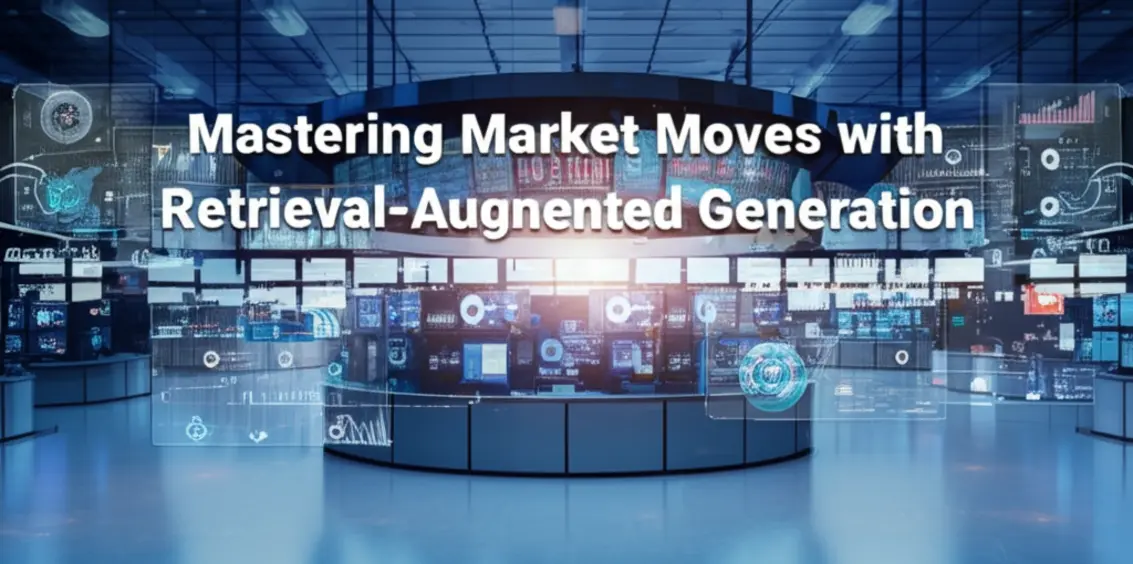Discover the power of Retrieval-Augmented Generation in dynamically accessing real-time data for trading success and enhancing trust through transparency.
Harnessing Real-Time Data: The Power of Dynamic Information Retrieval in RAG

Retrieval-Augmented Generation (RAG) is revolutionizing the capabilities of large language models (LLMs) by integrating dynamic information retrieval into the generation process. This fusion allows LLMs to enhance the accuracy and relevance of their responses by accessing real-time information from external databases and the web, rather than solely relying on pre-existing datasets.
At the heart of this approach lies a streamlined process that unfolds in several stages. Indexing is the foundational step, where large volumes of data are transformed into numerical embeddings stored within vector databases, thus enabling quick and precise document retrieval. As a query is raised, the retrieval phase activates, with document retrievers scouring the indexed data for pertinent information, employing a range of techniques from keyword matching to sophisticated semantic similarity assessments.
The next stage, augmentation, involves the synthesis of this retrieved information with the user’s original query, crafting an enriched prompt that provides the LLM with nuanced context. This stage is crucial as it ensures that the generated responses are not only grounded in up-to-date information but also tailored to the user’s specific needs.
Finally, the generation phase begins. Here, the LLMs utilize the augmented prompt to produce responses that are markedly more precise and contextual. By weaving in real-time, external data, RAG significantly mitigates the problem of AI hallucinations—where models might fabricate details or operate on outdated information.
The practical benefits of this advanced retrieval process are manifold. Besides improving accuracy, it bolsters the contextual understanding of nuanced subjects, making RAG exceptionally valuable in specialized fields. As a result, businesses are increasingly leveraging RAG to enhance customer service by delivering quick, accurate information from vast internal resources.
Despite its myriad advantages, the process of dynamic information retrieval is not without challenges. The success of RAG heavily depends on the quality of the external data it accesses. Low-quality sources can severely compromise the reliability of AI outputs. Additionally, integrating with external datasets escalates privacy and security concerns, particularly when handling sensitive information. Further complexity arises when establishing and maintaining the infrastructure required for RAG, which demands sophisticated understanding and constant refinement.
Innovations within this domain continue to push boundaries. Techniques like Corrective RAG (CRAG) introduce validation steps to enhance accuracy, albeit at the cost of increased latency. Meanwhile, multimodal approaches incorporate diverse data types, such as text and images, providing richer insights and elevating performance in fields like healthcare and education.
Dynamic information retrieval within RAG represents a significant stride towards enhancing the capability and reliability of AI-driven systems. By leveraging the vast expanse of real-time data, RAG is reshaping how AI interacts with information, opening new avenues for innovation across various sectors.
Harnessing Real-Time Data: The Power of Dynamic Information Retrieval in RAG

Retrieval-Augmented Generation (RAG) is revolutionizing the capabilities of large language models (LLMs) by integrating dynamic information retrieval into the generation process. This fusion allows LLMs to enhance the accuracy and relevance of their responses by accessing real-time information from external databases and the web, rather than solely relying on pre-existing datasets.
At the heart of this approach lies a streamlined process that unfolds in several stages. Indexing is the foundational step, where large volumes of data are transformed into numerical embeddings stored within vector databases, thus enabling quick and precise document retrieval. As a query is raised, the retrieval phase activates, with document retrievers scouring the indexed data for pertinent information, employing a range of techniques from keyword matching to sophisticated semantic similarity assessments.
The next stage, augmentation, involves the synthesis of this retrieved information with the user’s original query, crafting an enriched prompt that provides the LLM with nuanced context. This stage is crucial as it ensures that the generated responses are not only grounded in up-to-date information but also tailored to the user’s specific needs.
Finally, the generation phase begins. Here, the LLMs utilize the augmented prompt to produce responses that are markedly more precise and contextual. By weaving in real-time, external data, RAG significantly mitigates the problem of AI hallucinations—where models might fabricate details or operate on outdated information.
The practical benefits of this advanced retrieval process are manifold. Besides improving accuracy, it bolsters the contextual understanding of nuanced subjects, making RAG exceptionally valuable in specialized fields. As a result, businesses are increasingly leveraging RAG to enhance customer service by delivering quick, accurate information from vast internal resources.
Despite its myriad advantages, the process of dynamic information retrieval is not without challenges. The success of RAG heavily depends on the quality of the external data it accesses. Low-quality sources can severely compromise the reliability of AI outputs. Additionally, integrating with external datasets escalates privacy and security concerns, particularly when handling sensitive information. Further complexity arises when establishing and maintaining the infrastructure required for RAG, which demands sophisticated understanding and constant refinement.
Innovations within this domain continue to push boundaries. Techniques like Corrective RAG (CRAG) introduce validation steps to enhance accuracy, albeit at the cost of increased latency. Meanwhile, multimodal approaches incorporate diverse data types, such as text and images, providing richer insights and elevating performance in fields like healthcare and education.
Dynamic information retrieval within RAG represents a significant stride towards enhancing the capability and reliability of AI-driven systems. By leveraging the vast expanse of real-time data, RAG is reshaping how AI interacts with information, opening new avenues for innovation across various sectors.
Final thoughts
RAG empowers traders with real-time insights and transparent systems, reshaping strategies for informed and trustworthy decisions.
Ready to elevate your business with cutting-edge automation? Contact Minh Duc TV today and let our expert team guide you to streamlined success with n8n and AI-driven solutions!



